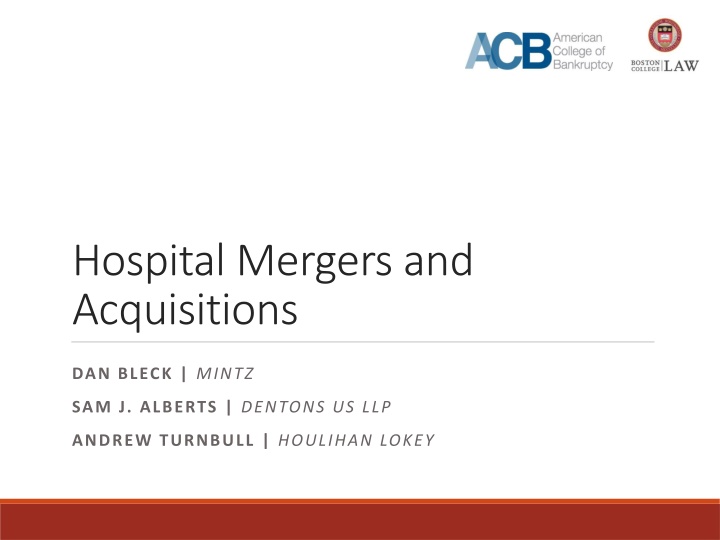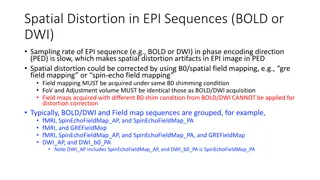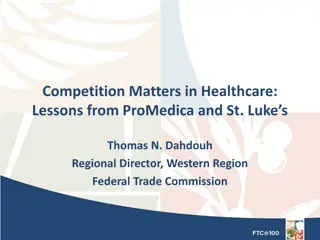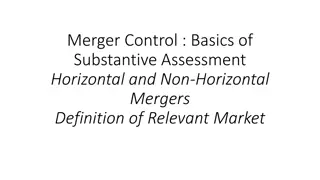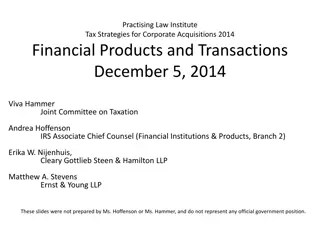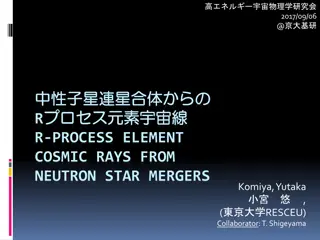U.S. Healthcare Mergers and Acquisitions Overview
This article provides insights into the trends and activities of mergers and acquisitions in the U.S. healthcare sector, focusing on transaction volumes, sub-sectors involved, and the treatment of provider agreements in bankruptcy cases. It discusses the complexities involved in obtaining provider agreements, the debate surrounding their classification, and the implications for buyers and sellers in the context of bankruptcy proceedings.
Uploaded on Mar 19, 2025 | 2 Views
Download Presentation

Please find below an Image/Link to download the presentation.
The content on the website is provided AS IS for your information and personal use only. It may not be sold, licensed, or shared on other websites without obtaining consent from the author.If you encounter any issues during the download, it is possible that the publisher has removed the file from their server.
You are allowed to download the files provided on this website for personal or commercial use, subject to the condition that they are used lawfully. All files are the property of their respective owners.
The content on the website is provided AS IS for your information and personal use only. It may not be sold, licensed, or shared on other websites without obtaining consent from the author.
E N D
Presentation Transcript
Hospital Mergers and Acquisitions DAN BLECK | MINTZ SAM J. ALBERTS | DENTONS US LLP ANDREW TURNBULL | HOULIHAN LOKEY
U.S. Healthcare M&A Activity Annual U.S. HC M&A Transaction Volume Healthcare Services Pharma / Life Sciences Med. Tech / Device 1,990 226 1,776 235 495 1,343 1,278 515 139 1,146 159 121 337 344 266 1,269 1,026 867 775 292 747 70 192 2019 2020 2021 2022 2023 YTD Q1-24 Source: S&P Capital IQ. Data as of 4/19/24. Note: Transaction count is based on announcement date. Total transaction value is based on deals with announced transaction values. 2
U.S. Healthcare M&A Activity Annual M&A Volume by Sub-Sector HCIT Multi-Site LTC Misc. Acute Care Behavioral Homecare Pharma Services 1,269 Annual M&A Volume - Acute Care 74 118 1,026 46 2015 2016 2017 2018 2019 2020 2021 2022 2023 120 97 101 78 68 49 46 23 31 75 867 223 76 46 68 775 747 65 98 33 23 126 68 40 149 31 49 168 85 169 56 414 86 45 309 287 241 254 72 192 21 13 296 54 226 219 213 10 182 58 32 32 2019 2020 2021 2022 2023 YTD Q1-24 Source: S&P Capital IQ. Data as of 4/19/24. Note: Transaction count is based on announcement date. 3
Provider Agreements in Bankruptcy Health Insurance Benefit Agreements ( Provider Agreements ) between the United States Government or state governments and healthcare providers govern the relationship between the Medicare/Medicaid programs and providers. Obtaining a new Provider Agreement can be a lengthy process, and thus hospital buyers may seek to obtain Provider Agreements from seller-debtors as part of the assets being transferred. There is debate over whether Provider Agreements are executory contracts or licenses. 4
Provider Agreements in Bankruptcy The treatment of Provider Agreements is vital to the success of a sale case, and the implications of treating Provider Agreements as executory contracts versus licenses are significant: Executory contracts must be assumed and assigned under section 365 of the Bankruptcy Code, i.e., the debtor must cure existing defaults and the buyer must shoulder successor liability. Liabilities may include monies owed to the Government (including overpayments from CMS to the seller-debtors), fraud allegations against the seller-debtors, and other unliquidated contingent liabilities. Licenses can be transferred free and clear of any interest under section 363, i.e., without successor liability. A seller-debtor maximizes the value of its assets if it transfers its Provider Agreement as a license without successor liability. On the other hand, if the seller-debtor must assume and assign its Provider Agreement as an executory contract, the buyer may adjust for the risk of successor liability by depressing the purchase price. 5
Provider Agreements in Bankruptcy The issue of whether Provider Agreements are executory contracts or licenses was litigated in In re Verity Health System of California, Inc., 606 B.R. 843 (2019) in the context of the transfer of a Provider Agreement in the chapter 11 case of Verity Health System of California, Inc. ( Verity ). In Verity,the C.D. Cal. Bankruptcy Court held, in a comprehensive opinion, that the Provider Agreement at issue there: a) was in the nature of a statutory entitlement, and not a contract, and did not need to be assumed to be transferred; b) could be sold, outside the ordinary course of debtors business, in same fashion as other estate assets; and c) could be transferred to purchaser of a debtor s assets free and clear of all liabilities which the state alleged had attached thereto. 6
Regulatory Approval of Sales Hospital sales require approvals from local regulators and state attorneys general. Under section 363(d) of the Bankruptcy Code, a nonprofit debtor may sell property only in accordance with nonbankruptcy law applicable to the transfer of property by a nonprofit entity. Section 541(f) allows a nonprofit healthcare debtor to transfer property to a for- profit entity, but only under the same conditions that would apply if the debtor were not in bankruptcy Sale transactions and the value of such transactions may be significantly impacted by the approval rights of and conditions imposed by third-party regulators. 7
Regulatory Approval of Sales At least one court has found that regulator-imposed sale conditions are subject to court approval. In Verity (2019), debtors sought to sell four hospitals free and clear of certain conditions imposed by the California Attorney General which would place an additional $305 million burden on the purchaser. In authorizing the debtors to sell the hospitals free and clear of the conditions, the C.D. Cal. Bankruptcy Court found: a) the conditions are interests in property within the meaning of section 363(f); b) the conditions are successor liabilities, and California law does not allow the Attorney General to impose successor liabilities; c) the imposition of the conditions is subject to judicial review by administrative mandate under California law; and d) the Attorney General abused his discretion in imposing the conditions. 8
Regulatory Approval of Sales Based upon the specific state, regulatory approvals may take many months. Parties should expect and plan for delays in sale transactions based on the need for regulatory approvals. Such delays give successful bidders the opportunity to renegotiate the purchase price. Parties should consider the treatment of back-up bids where regulatory delays are expected. States are increasingly raising the bar for private equity hospital acquisitions by enacting laws requiring corporate buyers to notify states of planned acquisitions and allowing authorities to block deals. For example, some states are considering bills that would ban private equity from healthcare acquisitions and strengthen merger review rules. 9
Highest and Best Bid The overarching goal of a 363 auction is to obtain the highest and best bid for a debtor s assets. In a nonprofit setting, this may involve an economic return v. mission preservation tension. In In re HHH Choices Health Plan, LLC, 554 B.R. 697 (2016), the S.D.N.Y. Bankruptcy Court approved the sale of a CCRC to an operator who offered less cash rather than to a rental model seller who offered more cash. The Court held that the objective of paying creditors as much as possible should be balanced against the consideration of serving a debtor s mission. Here, the winning proposal was more fully aligned with the debtor s mission. In In re United Healthcare System, Inc., 1997 WL 176574 (1997), the D.N.J. District Court held that parties to a sale must consider the fact of whether a debtor is a charitable institution, and that the officers and directors of a nonprofit organization are charged with the fiduciary duty to act in furtherance of the charitable mission. The Court also stated that a bankruptcy court may not focus solely on price when considering a sale. 10
Transition Services Agreements (TSAs) Designed to permit a purchaser to own and operate a facility pending approval of the transfer of the Medicare and Medicaid relationship, a provider agreement or another critical agreement (e.g., a pharmacy license). Under a TSA (sometimes called a Management Services Agreement) the sale is completed, and the buyer then leases the facility back to the seller, which then enters into a management agreement with the buyer to run the hospital and bill Medicare under the seller s provider number. In general, under Medicare regulations (42 C.F.R. 489.18) a transaction in which a new legal entity becomes the owner and operator of a Medicare-enrolled provider constitutes a change of ownership. Change of ownership is a term of art in the Medicare program and is sometimes abbreviated as CHOW. The period of the TSA generally runs from the closing of the sale to the CHOW approval. 11
Transition Services Agreements (TSAs) Permits purchaser to manage facility, sometimes with some assistance of seller but frequently with minimal oversight. Management and key employees roles, duties and compensation should be detailed. Agreement should provide expressly what manager can and cannot do and who it may and may not bind. Maintenance, insurance, risk of loss, entitlement to assets (A/R, QAF payments, insurance) should be spelled out in the TSA or at least incorporated by reference to the APA. Cooperation clauses, both between the parties and with third parties (including regulators) should be included. Dispute resolution provisions, jurisdiction and venue should be included. If in bankruptcy, Bankruptcy Court is normal venue. Should be attached as an exhibit to the APA. If sale is in Bankruptcy, should be approved by the Bankruptcy Court. 12
